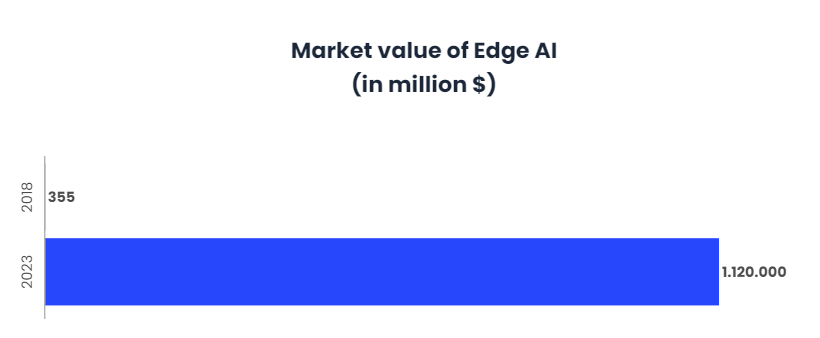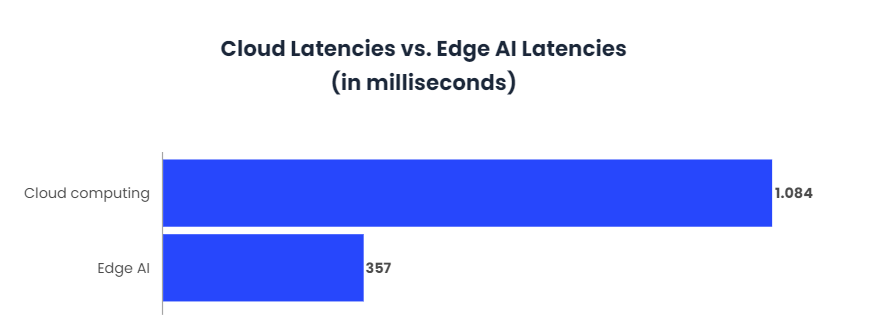Edge AI: The Future of Artificial Intelligence

In recent years, the applications of Artificial Intelligence have improved considerably around the world. With the growth of corporate activities at work, cloud computing has become a central part of AI evolution. In addition, as customers increasingly use their devices, businesses are becoming more aware of the need to bring the technology to those devices to be closer to customers and better serve their needs. This is why the Edge Computing market will continue to grow in the coming years.

The future of Artificial Intelligence is on the Edge
Edge AI is a system that uses Machine Learning algorithms to process data generated by a hardware device at the local level. The device does not need to be connected to the Internet to process such data and make decisions in real time, in a matter of milliseconds. This considerably reduces the communication costs derived from the cloud model. In other words, Edge AI takes the data and its processing to the closest point of interaction with the user, whether it is a computer, an IoT device or an Edge server.
An example of this technology can be seen in the speakers of Google, Alexa or the Apple Homepod, which have learned words and phrases through Machine Learning and then stored them locally on the device. When the user communicates something to applications such as Siri or Google, they send the voice recording to an Edge network where it is passed to text via AI and a response is processed. Without an Edge network the response time would be seconds, with Edge the times are reduced to less than 400 milliseconds.

Edge AI eliminates the privacy issue of transmitting millions of data and storing it in the cloud, as well as the bandwidth and latency limitations that reduce data transmission capacity.
Edge technology is essential for many industries, for example, for autonomous cars will help reduce power consumption by increasing battery durability. It will also be applicable to robots, surveillance systems and others. As a result, the market for Edge AI software is expected to grow in value from $355 million in 2018 to $1.12 trillion by 2023.
Benefits of Edge AI
Some of the main advantages offered by Edge AI are:
- Reduces costs and latency times for an improved user experience This facilitates the integration of wearable technologies focused on the user experience, where you interact in real time to make payments, or where bracelets monitor your exercise and sleep patterns.
- It increases the level of security in terms of data privacy through local processing. Data is no longer shared in a centralized cloud.
- Technically, the reduction in required bandwidth should lead to a reduction in the costs of the contracted internet service.
- Edge technology devices do not require specialized maintenance by data scientists or AI developers. The graphic data flows are automatically delivered for monitoring, therefore, it is an autonomous technology.
Why is Edge AI important?
On the other hand, the list of Edge AI applications is long. Current examples include facial recognition and real-time traffic updates on smartphones, as well as semi-autonomous vehicles or smart devices. Other Edge AI-enabled devices include video games, smart speakers, robots, drones, security cameras, and wearable health monitoring devices. Below are a few more areas where Edge AI is expected to continue to be used:
- It will provide intelligence to the security camera detection process. Traditional surveillance cameras record images for hours and then store and use them if necessary. However, with Edge AI, the algorithmic processes will be carried out in real time in the system itself, so the cameras will be able to detect and process suspicious activities in real time, for a more efficient and less expensive service.
- The autonomous vehicles will increase their capacity to process data and images in real time for the detection of traffic signs, pedestrians, other vehicles, and roads, improving the levels of security in transportation.
- It will be possible to use it in image and video analysis, to generate responses to audiovisual stimuli, or for real-time recognition of scenes and spaces, for example, in smartphones.
- It will reduce costs and improve safety in terms of industrial IoT (IIoT). The AI will monitor machinery for possible defects or errors in the production chain, while the Machine Learning will recompile data in real time of the whole process.
- It will be used for the analysis of medical images in emergency medical care.
- The deployment of 5G technology networks will mean greater speed and very low latency for mobile data transmission, making Edge AI more useful. Companies have already embraced this, and for example, IBM and Red Hat have partnered to launch 5G-based edge solutions to enable companies to more easily manage workloads across a massive volume of devices from different vendors, giving the telecommunications industry the agility it needs to quickly deliver services to its customers.
There are no application limits for Edge AI technology. After the crisis of the Covid-19, the ingenuity of the companies has led to deploy solutions based on Artificial Intelligence to provide accurate information in real time. In healthcare, for example, AI is helping with patient monitoring, testing and treatment.
The creativity and imagination of the developer community is the only real limit of Edge technology. That is why there are already collaborative projects trying to train students and professionals with STEM profile in this new technology.
An example of this is that of Intel and Udacity, which are collaborating in the Intel Edge AI for IoT Developers Nanodegree programme, with the aim of training the developer community in Deep Learning and Computer Vision. This includes software engineers, machine learning engineers, data scientists, and all those involved in the development of cloud-based AI applications. The program is expected to lead to more user-oriented Edge AI application development.
Conclusions
As users spend more time with their mobile devices, more companies and developers understand the importance of deploying Edge technology to provide more immediate and efficient service, while improving their profit margin. This will open up a new world of possibilities in terms of enterprise-level AI-based services and user convenience and satisfaction.
Large companies like Amazon and Google have been investing millions in the development of their Edge AI systems, so the only way to stay competitive is to take a lead and invest in these technologies. On the other hand, the increase in demand for IoT devices will facilitate the adoption of 5G networks and Edge Computing itself.
However, there is a false notion that Edge technology will replace the cloud; this is not true, Edge will work in a complementary way with the cloud. Data will continue to be processed in the cloud, but user-generated data that belongs only to users can be operated and processed on Edge.


